Nursecate
On this page, you find all documents, package deals, and flashcards offered by seller NURSECATE.
- 537
- 0
- 0
Community
- Followers
- Following
537 items
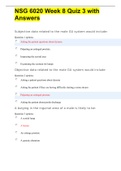
NSG 6020 Week 8 Quiz 3 with Answers
Subjective data related to the male GU system would include: Question 1 options: Asking the patient questions about dysuria Palpating an enlarged prostate. Inspecting the scrotal area Examining the scrotum for lumps Objective data related to the male GU system would include Question 2 options: Asking a patient questions about dysuria Asking the patient if they are having difficulty starting a urine stream Palpating an enlarged prostate Asking the patient about ...
- Exam (elaborations)
- • 2 pages •
Subjective data related to the male GU system would include: Question 1 options: Asking the patient questions about dysuria Palpating an enlarged prostate. Inspecting the scrotal area Examining the scrotum for lumps Objective data related to the male GU system would include Question 2 options: Asking a patient questions about dysuria Asking the patient if they are having difficulty starting a urine stream Palpating an enlarged prostate Asking the patient about ...

NSG 6020 Respiratory - Question and Answers
1. The anterior surface landmark on the thorax that is denoted by a hollow U-shaped depression just above the sternum and between the clavicles is termed the: suprasternal notch 2. Increased anteroposterior diameter of the chest, purse-lipped breathing, and dyspnea with talking, suggest: chronic obstructive pulmonary disease 3. The line that extends through the inferior angle of the scapula when the arms are at the sides of the body is the: scapular line 4. The lower tip of the scapula is loc...
- Exam (elaborations)
- • 6 pages •
1. The anterior surface landmark on the thorax that is denoted by a hollow U-shaped depression just above the sternum and between the clavicles is termed the: suprasternal notch 2. Increased anteroposterior diameter of the chest, purse-lipped breathing, and dyspnea with talking, suggest: chronic obstructive pulmonary disease 3. The line that extends through the inferior angle of the scapula when the arms are at the sides of the body is the: scapular line 4. The lower tip of the scapula is loc...

NSG 6020 Week 5 Midterm Exam 2 with Answers
1. A patient tells the nurse that she has had abdominal pain for the past week. What would be the best response by the nurse? 1. “Can you point to where it hurts?” 2. “We’ll talk more about that later in the interview.” 3. “What have you had to eat in the last 24 hours?” 4. “Have you ever had any surgeries on your abdomen?” ANS: 1 A final summary of any symptom the person has should include, along with seven other critical characteristics, “Location: specific.” Ask ...
- Exam (elaborations)
- • 6 pages •
1. A patient tells the nurse that she has had abdominal pain for the past week. What would be the best response by the nurse? 1. “Can you point to where it hurts?” 2. “We’ll talk more about that later in the interview.” 3. “What have you had to eat in the last 24 hours?” 4. “Have you ever had any surgeries on your abdomen?” ANS: 1 A final summary of any symptom the person has should include, along with seven other critical characteristics, “Location: specific.” Ask ...
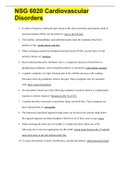
NSG 6020 Cardiovascular Disorders
1. In order to bring the ventricular apex closer to the chest wall when assessing the point of maximal impulse (PMI), ask the patient to: turn to the left side 2. The tonsillar, submandibular, and submental nodes drain the lymphatic fluid from portions of the: mouth, throat, and face 3. When screening a patient for peripheral arterial disease (PAD), one risk factor would include a history of: smoking 4. Heart sounds produced by turbulence due to a temporary increase in blood flow in predispo...
- Exam (elaborations)
- • 12 pages •
1. In order to bring the ventricular apex closer to the chest wall when assessing the point of maximal impulse (PMI), ask the patient to: turn to the left side 2. The tonsillar, submandibular, and submental nodes drain the lymphatic fluid from portions of the: mouth, throat, and face 3. When screening a patient for peripheral arterial disease (PAD), one risk factor would include a history of: smoking 4. Heart sounds produced by turbulence due to a temporary increase in blood flow in predispo...

NSG 6020 Week 1 Quiz 1 with Answers
Question 1 When recording assessments during the construction of the problem-oriented medical record, the examiner should: Response Feedback: Once the examiner has a list of problems constructed, then an assessment is made for each unique problem. Question 2 What finding is unique to the documentation of a physical examination of an infant? Response Feedback: The size & characteristic of the fontanel are unique & important in the assessment of an infant. Data on l...
- Exam (elaborations)
- • 3 pages •
Question 1 When recording assessments during the construction of the problem-oriented medical record, the examiner should: Response Feedback: Once the examiner has a list of problems constructed, then an assessment is made for each unique problem. Question 2 What finding is unique to the documentation of a physical examination of an infant? Response Feedback: The size & characteristic of the fontanel are unique & important in the assessment of an infant. Data on l...
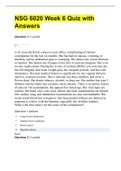
NSG 6020 Week 6 Quiz with Answers
Question 1 (1 point) A 42-year-old florist comes to your office, complaining of chronic constipation for the last six months. She has had no nausea, vomiting, or diarrhea, and no abdominal pain or cramping. She denies any recent illnesses or injuries. She denies any changes to her diet or exercise program. She is on no new medications. During the review of systems (ROS), you note that she has felt fatigued, had some weight gain, has irregular periods, and has cold intolerance. Her past me...
- Exam (elaborations)
- • 10 pages •
Question 1 (1 point) A 42-year-old florist comes to your office, complaining of chronic constipation for the last six months. She has had no nausea, vomiting, or diarrhea, and no abdominal pain or cramping. She denies any recent illnesses or injuries. She denies any changes to her diet or exercise program. She is on no new medications. During the review of systems (ROS), you note that she has felt fatigued, had some weight gain, has irregular periods, and has cold intolerance. Her past me...

NURS 6501 Week 1 Quiz.docx
• Question 1 1 out of 1 points An aide asks the nurse why people who have neurofibromatosis will show varying degrees of the disease. Which genetic principle should the nurse explain to the aide? Selected Answer: b. Expressivity Correct Answer: b. Expressivity • Question 2 1 out of 1 points Why is potassium able to diffuse easily in and out of cells? Selected Answer: c. Because the resting plasma membrane is more permeable to potassium Correct Answer: ...
- Exam (elaborations)
- • 6 pages •
• Question 1 1 out of 1 points An aide asks the nurse why people who have neurofibromatosis will show varying degrees of the disease. Which genetic principle should the nurse explain to the aide? Selected Answer: b. Expressivity Correct Answer: b. Expressivity • Question 2 1 out of 1 points Why is potassium able to diffuse easily in and out of cells? Selected Answer: c. Because the resting plasma membrane is more permeable to potassium Correct Answer: ...
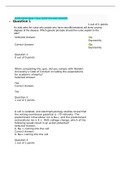
NURS 6501N Week 1 Quiz QUESTION AND ANSWER
• Question 1 1 out of 1 points An aide asks the nurse why people who have neurofibromatosis will show varying degrees of the disease. Which genetic principle should the nurse explain to the aide? Selected Answer: b. Expressivity Correct Answer: b. Expressivity Question 1 0 out of 0 points When completing this quiz, did you comply with Walden University’s Code of Conduct including the expectations for academic integrity? Selected Answer: Yes Correct Answer...
- Exam (elaborations)
- • 29 pages •
• Question 1 1 out of 1 points An aide asks the nurse why people who have neurofibromatosis will show varying degrees of the disease. Which genetic principle should the nurse explain to the aide? Selected Answer: b. Expressivity Correct Answer: b. Expressivity Question 1 0 out of 0 points When completing this quiz, did you comply with Walden University’s Code of Conduct including the expectations for academic integrity? Selected Answer: Yes Correct Answer...
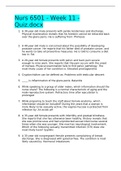
Nurs 6501 - Week 11 - Quiz.docx
1. A 30-year-old male presents with penile tenderness and discharge. Physical examination reveals that his foreskin cannot be retracted back over the glans penis. He is suffering from: Phimosis 2. A 40-year-old male is concerned about the possibility of developing prostate cancer. He reports that his father died of prostate cancer, and he wants to take all preventive measures. He is told to consume a diet low in: Fat 3. A 20-year-old female presents with pelvic and back pain severe enough ...
- Exam (elaborations)
- • 5 pages •
1. A 30-year-old male presents with penile tenderness and discharge. Physical examination reveals that his foreskin cannot be retracted back over the glans penis. He is suffering from: Phimosis 2. A 40-year-old male is concerned about the possibility of developing prostate cancer. He reports that his father died of prostate cancer, and he wants to take all preventive measures. He is told to consume a diet low in: Fat 3. A 20-year-old female presents with pelvic and back pain severe enough ...

NURS 6501N Week 10 Quiz 5 - Question and Answers
• Question 1 1 out of 1 points A 4-year-old male is diagnosed with nephrotic syndrome. Which of the following assessment findings accompanies this condition? Selected Answer: a. Proteinuria Correct Answer: a. Proteinuria • Question 2 1 out of 1 points A 25-year-old female is diagnosed with urinary tract obstruction. While planning care, the nurse realizes that the patient is expected to have hydronephrosis and a decreased glomerular filtration rate caused by: ...
- Exam (elaborations)
- • 10 pages •
• Question 1 1 out of 1 points A 4-year-old male is diagnosed with nephrotic syndrome. Which of the following assessment findings accompanies this condition? Selected Answer: a. Proteinuria Correct Answer: a. Proteinuria • Question 2 1 out of 1 points A 25-year-old female is diagnosed with urinary tract obstruction. While planning care, the nurse realizes that the patient is expected to have hydronephrosis and a decreased glomerular filtration rate caused by: ...
